Final report for FNC16-1031
Project Information
My personal operation is small, but the plans are to grow it steadily over the next several years. I have 33 acres of pasture that currently have 10 goats and 2 heifers full time, and my brother-in-law's herd of 25-ish head of cattle part-time. My father-in-law has practiced sustainable practices on his crop land, such as no-till and cover crops, but nothing sustainable has been done with the pasture land until this grant was started.
My main work activities this year involved a lot of fencing, and a lot of learning the behavior of goats. I also experimented with a portable fence system made of t-posts and cattle panels which worked, but was too labor intensive to be cost effective long term.
No cedar trees have been completely consumed so far. Many have been nibbled on, but I have not been successful at getting the goats to concentrate on a small batch of trees until consumed yet. That will be the objective for next year; to learn how to get the goats to concentrate their efforts on a few trees without hurting their health.
January 2018 update:
There has been a lot learned over this past year. The problem this grant addressed is thousands of Cedar tree seedlings on 33 acres of pasture. The original goal was to use goats to eat, and thus kill, the seedlings. Unfortunately, it has not panned out as hoped. But there was still a lot learned. I have discovered a lot about goat behavior, as well as some alternative methods to clear Cedar tree seedlings. I also cut down mature Cedar trees to prevent the future production and spreading of seeds.
My goats were also taken to the local county fair. Two members of the local 4-H club worked with some of my goats and learned all about the care and handling of goats. One of them went on to win a purple ribbon at the fair! I was happy to use this grant as a way to educate young people about animal husbandry and proper handling of livestock.
The proposal for this grant is twofold. First, introduce 6 goats onto the west 33 acres of pasture, containing them to small areas of the pasture at a time with electric fencing. The objective would be to manage grazing pressure so that goat browsing would result in cedar defoliation. Cedar trees do not regrow after all the green is removed.
The portable electric fencing will allow great flexibility in controlling the grazing pressure of the goats in an area of pasture. Secondly, rotational, multi-livestock grazing will be implemented on the same pasture. Using a combination of permanent and portable electric fencing, the pasture will be broken into paddocks, and each paddock will be strip grazed using the portable electric fencing. The goats can run over the area first, eating the cedar trees. The cattle will follow behind, eating the pasture grasses, encouraging them to sprout new growth. By rotational grazing the cattle behind the goats, the pasture soil will become more vigorous and healthier than it currently is, giving the grasses an upper hand over the invasive cedar trees. By weakening/killing the cedar trees and simultaneously strengthening the pasture soil, the spread of the cedar tree seedlings could be halted and reversed.
January 2018 update:
The objectives of this grant were mostly the same, with the addition of finding other alternative methods to control Cedar trees. Read the research sections to learn more about my success finding other methods of control.
Research
My process for conducting this grant was based on the scientific method. I would come up with a hypothesis, research that idea to see if it was feasible, and then test it. I would venture to say that the goats are the wild card; they have their own personalities and other farmers' outcomes may be different than my own. My own experience with goats was great; I just could not get them to eat Cedar trees! Everything I did with shredding trees, cutting them down with loppers, and cutting mature Cedars is easily repeatable by others. There is plenty of research on the benefits of rotational grazing also, both by other grants through SARE, and internet articles and books.
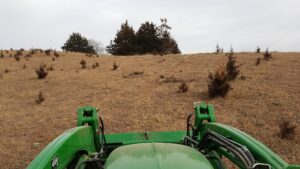
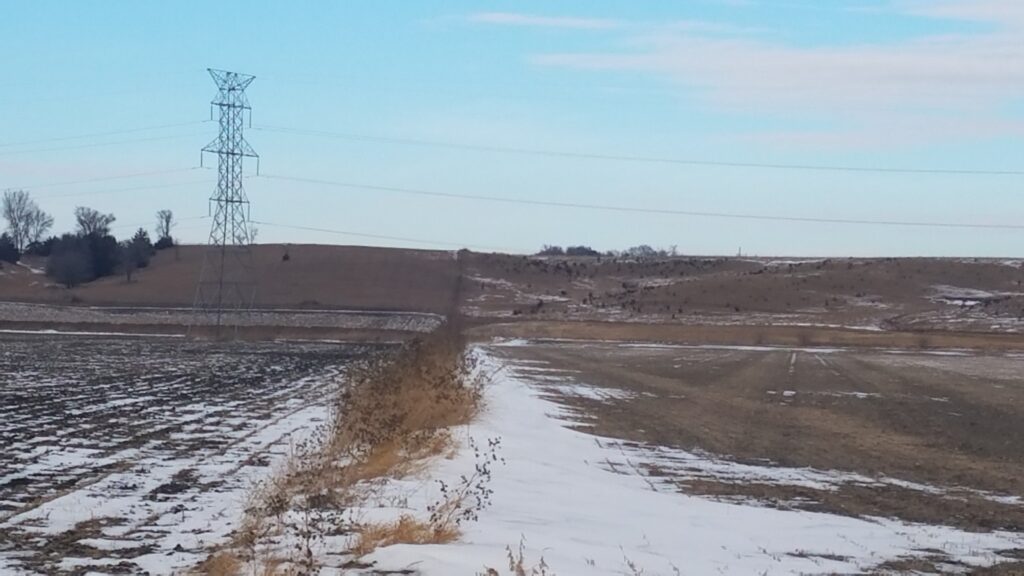
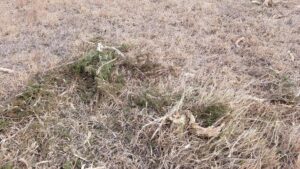
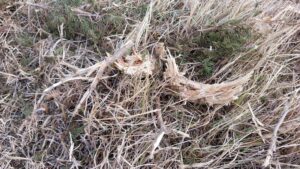
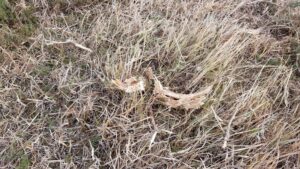
Impacts
The outcome so far has been that the cedar trees have not been impacted by the goats. They have nibbled on them many times, but they do not devour a single tree before moving on. My hope is that the winter will lead to more trees being consumed since the pasture has little else in it to eat.
The results have been less than stellar. While I have observed the goats eating cedar trees with great enjoyment at times, most of the time they ignore the trees. When they do eat the trees, it is usually a nibble here and a nibble there. This is most likely due to the fact that goats are browsers, not grazers. They are not content to stay in one area long, but rather move around the pasture. When I was experimenting with the portable cattle panel setup, the goats did eat most of the trees inside the perimeter, but at the cost of their health. They started getting skinny. My conclusion so far is that while it is possible to get goats to eat the trees, to get them to kill trees will come at the cost of their health without a very watchful eye on the part of the farmer. In the time that it takes to manage goats to that point, 10 times the trees could be cut down by hand with minimal effort.
I have also learned that goats do not respect temporary electric fencing. They tend to plow through instead of back away from the fencing if they touch it. Baby goats could be trained, but I have so far had little luck training my older goats. I will continue to experiment though.
January 2018 update:
The impact was very similar to last year. However I learned a lot about goat behavior, alternative methods for clearing Cedar trees, and pasture health. I have a new game plan to implement in the coming years. Read the "Accomplishments" section for more details.
Outreach
This year I have not done as much information sharing as I plan to do next year, but I did start a project with three local 4H’ers. They helped me with some fencing one Saturday morning, and we meet monthly before their 4H meeting to go over topics regarding general goat health and care. This next summer they will be helping me with more fencing, and they plan to show goats at the fair. It has been fun to see them learn and bond with the goats.
January 2018 update:
Two local 4-Hers did a fair project with my goats. They learned all about fencing, animal husbandry, how to show an animal at the fair, and care of goats. It was a lot of fun to see them learn and get interested in livestock. One of them even won Grand Champion!
Accomplishments
Work Activities
My main work activities this year involved a lot of fencing, and a lot of learning the behavior of goats. While the plan was to do a lot of interior fencing, it became apparent the first day we brought home our goats that our perimeter fencing was in dire need of updating to make it goat-resistant. The perimeter fencing of our 33 acre pasture was updated with 48” tall field fence.
I also experimented with a portable fence system made of t-posts and cattle panels which worked, but was too labor intensive to be cost effective long term.
It has been a big learning curve working with goats compared to other livestock animals. They have huge personalities and are almost impossible to contain, yet you can’t really be mad at them when they break out. It has been a lot of fun; goats will be a long-term animal on our farm due to this grant. They are just like pets.
No cedar trees have been completely consumed so far. Many have been nibbled on, but I have not been successful at getting the goats to concentrate on a small batch of trees until consumed yet. That will be the objective for next year; to learn how to get the goats to concentrate their efforts on a few trees without hurting their health.
This next year I do still have a few ideas up my sleeve. Right now I have set a bale of alfalfa right next to a hillside covered in small cedar trees. This gets the goats out into the pasture during the winter when little else entices them. My hope is that by keeping the goats in the same area throughout the winter, they will start eating on those trees nearby while still having the nutrients of the alfalfa. This will hopefully lead to the same destruction of trees as in the portable cattle panel experiment, but without losing weight. If this works, it could be done on a larger scale with more goats and actually have an impact on a pasture. For this to be successful though, some of the trees will need to be completely stripped.
I also still plan to complete the interior fencing this spring and summer. This will allow me to better control where the goats are grazing and concentrate them more.
This winter yet I am going to cut down the mature cedar trees. That will remove the seed bank so this problem does not get more out of hand.
Lastly, I have one more experiment to try. When doing the research for the grant last year, I came across some research done by a man in North Dakota (I unfortunately do not remember his name). He stumbled across a potential solution for fast clearing of cedar trees, at least in northern states where it gets cold enough to have a week long or more of single digit weather. He discovered that in single digit weather, small cedar trees will snap off at the base if ran over with a tractor or hit with a tractor loader bucket. I am still waiting for a cold week here in SD to be able to try this. While I will not be using grant funds to try this, I will post my results in my final report.
January 2018 update:
First I will discuss goat behavior. I rarely observed the goats eating the Cedar trees, and when they did, it was just a nibble here and there until they moved on to the next plant in the pasture (they do however love to eat bull thistles! So if you have bull thistles, goats are your animal!). What was interesting, though, is that one evening I went out with a pruning lopper to cut down some seedlings on a hillside. I wanted to see just how long it would take to clear an area with loppers since the goats were not working as hoped. I observed a strange thing. Once I cut a seedling down (and we are talking about a 2′ high seedling, easily in the goat’s reach), the goats started running towards me and eating the seedlings like crazy! But only the ones I cut down were touched. Similarly, several weeks ago I cut down 10 mature Cedar trees in our pasture to stop the production and spreading of seeds. One of those trees was in the paddock the goats currently had access to. They devoured all the green on a 20′ tall mature Cedar once it was lying on the ground over a 10 hour period. So I am at a loss as to what draws them to freshly cut down Cedars, but prevents them from wanting to eat the seedlings that are scattered throughout the pasture, ready for the taking.
Next let’s talk about alternative methods of clearing these pesky Cedars. I started brainstorming other possible ideas to cut these down since the goats were not doing what I wanted. That led me to notice my neighbor's pasture directly adjacent to mine. He doesn’t have quite as steep hills and has no animals, so his pasture is baled every year. Consequently his pasture is clear of all Cedars. I asked my father-in-law about it, who informed me that several years ago there were Cedar trees on the land, but the owner used a shredder/rotary mower to cut the grass the first time before it was baled, and the trees were small enough to be cut too. And 4 years later, he has no Cedar tree seedlings. So before it snowed this winter, I borrowed my father-in-law’s utility tractor and shredder and tried out this hypothesis (one thing to note, I have some steep hillsides, so some will still have to be cleared by hand because a tractor cannot be driven safely on those hills. Always be careful when driving a tractor on hills). I drove to the first hill and started shredding, driving straight up and down the hill for safe tractor handling. And it worked! The trees were cut below all the branches, which from the research I have done on Cedar trees, will result in a dead tree. Only time will tell for sure. I have attached pictures of before and after, as well as a shot showing my pasture compared to my neighbors.
The last option for clearing trees that I experimented with is hand cutting with a lopper, as previously mentioned. This surprisingly wasn’t horrible. In an hour I cut down over 100 little seedlings, it wasn’t hard work, and I got to be outside enjoying the company of my goats. This would not be practical for large pastures of 100’s of acres, but for my 33 acres, it will work just fine. I plan to have all trees cleared through shredding and hand cutting by the end of next summer.
Now even though I have cut down the mature trees that bear seeds, I still needed a plan to prevent future seedlings from sprouting because I am sure there are thousands of seeds sitting in the soil just waiting for the right conditions to sprout into a pesky little tree. Plus, I have mature trees in the pastures of my neighbors surrounding me. The answer to this problem is rotational grazing. I was able to use electric fence to divide my pasture into 8 paddocks last summer, and move my brother-in-law’s cattle through each paddock roughly every 4 days. This visually benefited the pasture. There was less selecting of the choice plants and more trampling of mature, dead grasses, resulting in better pasture utilization and stronger plants that got a rest and chance to regrow before being regrazed. This next summer I will further divide each paddock into daily slices of pasture for the cattle. By doing so, the soils and plants will slowly become healthier, and any potential tree seedlings will have much stronger competition for resources. The cattle’s concentrated hooves will also work to further deter any newly sprouted seedlings from living. I am excited to see how my pasture is revitalized in the next several years by implementing these changes.
Overall, the goats did not take care of the Cedars as I was hoping, but I have a new plan of attack for the coming years, I have learned the joy of having goats on our farm, and I have learned a lot through this whole process.
Educational & Outreach Activities
Participation Summary:
I unfortunately did not have a lot of results to report, so the outreach activities focused on the two 4-Hers that did a goat project at the fair. They learned a lot, as discussed in other sections of this report.
If my proposed alternative methods pan out, I plan to share the results with my neighbors who are also battling Cedar tree problems. Almost every farmer has a shredder and tractor that could be used to replicate my proposed methods of cutting down seedlings.
Learning Outcomes
I learned a lot through this grant. Not only did I learn about the care of goats, but I also learned a lot about controlling Cedar trees and identified a few alternative ways to control them that I was not originally aware of at the beginning of this grant.
First, the goats did not devour the Cedar tree seedlings as hoped. I have discussed why elsewhere in this report. But, I did discover that a rotary mower makes quick work of clearing a hillside, as long as the terrain is not so steep as to inhibit a tractor from driving on it. Also, I have started rotational grazing the pasture which has already positively impacted the health of the pasture, further inhibiting the growth of new seedling sprouts because of less desirable pasture conditions and tougher competition in the strengthened grasses and other plants of the pasture.
There is little disadvantage to my new plan of rotary mowing and rotational grazing, provided you have access to a mower. Most farmers have one, so even if a farmer does not personally own one, a neighbor most likely does. It does take time and fuel to drive the tractor, but very little compared to cutting each seedling down by hand. And rotational grazing, once a farmer does the research and educates himself on it, can be implemented with little time and a small expense in some electric fencing material.
Overall I would recommend getting goats; they are just an amazing livestock creature capable of providing milk, meat, pasture cleanup (they love thistles), and income for the farm. I would also highly encourage farmers to rotational graze to improve their pastures.
Project Outcomes
I will be continuing my battle against the Cedar trees, as described above. I strongly believe that with enough creativity, any problem can be solved. This grant was eye opening and has already done a lot to revitalize my pastures, providing the basis for an income when I myself am able to transition to farming full time. Through careful, thoughtful changes to production practices, my pasture will continue to grow stronger and healthier, and I plan to share all my wins and mistakes with my neighbors and anyone who wants to know. I can be reached at 605-651-6090 by anyone who has questions about my journey through these last two years.